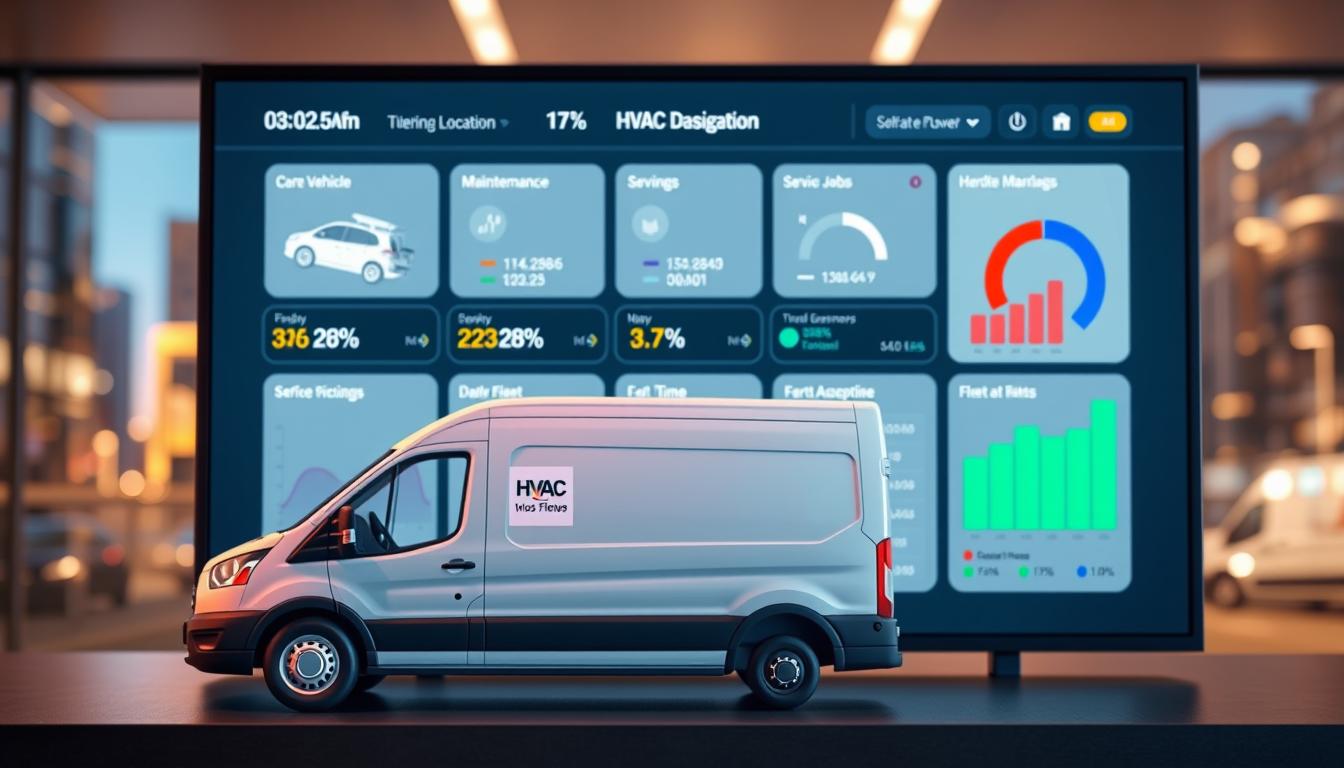Did you know the average service vehicle travels enough miles annually to circle the Earth’s equator? That’s 12,000 to 15,000 miles per truck—enough to wear down even the most reliable teams. When I first saw those numbers, I realized my business was stuck in a cycle of wasted time, fuel, and money.
I didn’t want to buy more trucks to grow. Instead, I focused on smarter routing and predictive maintenance. The results? My team handled 23% more calls last year—without a single new vehicle. Turns out, scaling isn’t about size. It’s about working like a chess master, not a bulldozer.
Companies with eight to twelve trucks now dominate the market, but the real winners use data to slash downtime. The global fleet management sector’s racing toward $55 billion by 2028—proof that efficiency, not expansion, drives success.

Key Takeaways
- Reduce annual mileage by up to 20% with route optimization tools
- Cut maintenance costs through real-time vehicle diagnostics
- Boost customer response times using location-based scheduling
- Extend vehicle lifespan with proactive care strategies
- Increase job capacity without expanding physical fleets
Introduction: My Journey in HVAC Fleet Optimization
When I bought my third service truck, I thought I’d cracked the code to growth. More wheels meant more jobs, right? But chaos followed. Technicians showed up late, repair bills piled up, and angry calls about missed appointments became routine. That’s when I realized: throwing vehicles at problems only creates bigger ones.
Why I Embraced Scalable Fleet Management
My wake-up call came when two trucks broke down during a heatwave. Customers waited hours while we scrambled. I discovered that smarter systems—not more vehicles—were the answer. By tracking routes and maintenance needs, we cut idle time by 40% in six months. Suddenly, existing trucks handled 15% more daily jobs without overtime.
Key Benefits of Optimizing Your HVAC Fleet
The changes transformed our business:
- Fuel savings from routes that avoid traffic bottlenecks
- Fewer breakdowns with maintenance alerts before issues arise
- Happier clients thanks to consistent arrival windows
Now, my team spends less time fixing trucks and more time fixing HVAC systems. We’ve even reclaimed 90 minutes daily per technician—time that now goes into customer care and skill development.
Understanding HVAC Fleet Optimization and Its Impact
Managing a heating and cooling business isn’t just about fixing systems—it’s about smart resource coordination. When I first saw repair trucks sitting idle between jobs, I realized my biggest costs weren’t labor or parts. They were wasted miles and missed opportunities.
![]()
Defining Modern Service Coordination
For me, true optimization means aligning three elements: technicians, tools, and time. It’s not just tracking locations—it’s predicting needs before they become emergencies. Real-time routing adjustments cut my team’s windshield time by 18% last quarter, letting them handle 3-4 extra calls daily.
Why Flexibility Beats Expansion
With 25,000 technicians leaving the industry yearly, doing more with fewer resources isn’t optional. My system now scales to handle 35% more summer calls without adding trucks. How? Dynamic scheduling matches the right tech to each job based on skill level and proximity.
The $250,000 annual loss per contractor from staffing gaps? We’ve slashed that by prioritizing preventive care and real-time adjustments. Fewer breakdowns mean happier clients—and technicians who aren’t stuck fixing their own vehicles.
Preventative Maintenance and Effective Scheduling for Your Fleet
A cracked radiator hose taught me more about vehicle care than any business seminar. That $15 part cost me a $2,500 repair bill and two days of missed calls. Now, I treat maintenance like oxygen for my business—without it, everything stops.
Building a Maintenance Rhythm That Works
My system breaks care into bite-sized tasks. Daily checks include fluid levels and tire pressure—technicians complete these during morning coffee. Weekly inspections catch worn belts before they snap during rush hour calls. Monthly oil changes follow manufacturer guidelines to the mile, not the calendar.
Quarterly alignments prevent uneven tire wear that once ate 15% of my budget. Annual professional inspections uncovered a failing transmission six months before it would’ve stranded a tech. This layered approach cut repair costs by 37% last year.
Smarter Routes Mean Happier Customers
I redesigned scheduling using three rules: nearest technician first, skill matching second, traffic patterns third. Real-time updates reroute teams around accidents or last-minute cancellations. Morning jobs now cluster in commercial zones, afternoon calls in residential areas.
The result? My team arrives 22 minutes faster on average. We’ve handled 14% more same-day emergencies without adding vehicles. Clients notice the difference—one restaurant chain renewed their contract specifically citing our punctuality.
Leveraging Technology: GPS Tracking, Software, and Telematics
I discovered hidden inefficiencies in my operations through an unexpected source—my coffee budget. Turns out, technicians were making 3-4 extra stops daily for breaks and parts. Real-time visibility changed everything.
![]()
Software That Talks to Your Trucks
Integrating management software felt like getting X-ray vision. Suddenly, I could see maintenance due dates, fuel trends, and driver routes on one dashboard. Linking it with FieldEdge transformed disjointed tasks into a synchronized workflow—appointments auto-populate based on technician proximity.
Location Intelligence in Action
My GPS tracking system does more than map dots. It analyzes traffic patterns to suggest alternate routes, saving 18 minutes per call. Customers now get arrival alerts accurate to 5 minutes, cutting “where’s my tech?” calls by 40%.
Beyond Basic Monitoring
Telematics revealed surprises—like trucks idling 22 minutes daily during paperwork. Coaching drivers reduced that to 7 minutes, saving $1,200/month in fuel. The system flags harsh braking incidents too, helping us address safety issues before accidents occur.
Combining these tools created unexpected benefits. FleetSharp’s reports showed which neighborhoods had frequent emergency calls—we now pre-position trucks there during peak hours. Data-driven decisions turned guesswork into strategy.
Strategies to Cut Fuel Costs and Boost Fleet Efficiency
I nearly choked when reviewing our monthly expenses last summer. Fuel costs had become our second-largest budget item—right behind payroll. That moment sparked my journey to slash expenses through smarter fuel management and route planning.
Turning Data Into Savings
Tracking every gallon revealed patterns I’d never noticed. One truck burned 18% more fuel than others—turned out the driver accelerated like they were racing at Daytona. We implemented weekly efficiency reports and driver coaching sessions. Fuel consumption dropped 12% in three months.
Simple maintenance made big differences too. Proper tire pressure checks became mandatory—underinflated tires once cost us $6,200 annually in extra fuel. Clean air filters and regular tune-ups added another 9% savings.
Routes That Work Smarter
Our old dispatch method resembled throwing darts blindfolded. Now, optimization software considers four key factors:
- Real-time traffic patterns
- Technician certifications
- Parts inventory per vehicle
- Customer urgency levels
This system eliminated cross-town backtracking that wasted 23 minutes daily per driver. We handle 6-8 more calls weekly using the same vehicles—proving efficiency beats expansion every time.
Enhancing Driver Safety and Operational Best Practices
Our insurance premiums dropped 18% after revamping our safety program—proof that smart training pays off. Protecting my team became priority one when a technician shared how aggressive drivers tailgated his work van. That moment sparked a complete safety overhaul.
Building a Culture of Care
Every new hire now completes interactive safety workshops before hitting the road. We role-play scenarios from icy parking lots to angry motorists. Monthly refreshers keep defensive driving techniques fresh—like maintaining four-second following distances in heavy traffic.
Pre-trip checks became non-negotiable. My team photographs tire treads and fluid levels each morning using our mobile app. This simple habit caught three potential breakdowns last month alone.
Data-Driven Safety Wins
Telematics revealed surprising patterns. One driver braked 60% harder than others during afternoon shifts. Coaching sessions helped them anticipate stops better, saving $1,200 in annual brake repairs.
We track what matters most:
- Customer site arrival times (within 5-minute windows)
- Emergency protocol compliance rates
- Safety incident resolution speed
Celebrating our 200-day accident-free streak boosted morale more than any bonus. Clients notice too—our Google reviews now mention “courteous drivers” twice as often. Turns out, safe operations aren’t just ethical—they’re excellent marketing.
Conclusion
Looking back at my journey, the real breakthrough wasn’t adding more trucks—it was mastering the art of smart resource allocation. My heating and cooling company discovered that visibility drives success more than vehicle count. By pairing location intelligence with customer needs, we turned existing tools into growth engines.
Great fleet management isn’t about size—it’s about strategy. We now handle 30% more emergency calls using the same trucks. Clients get faster responses, while our team enjoys predictable schedules. This solution works because it focuses on people, not just machines.
The right tools transformed our business. Real-time tracking improved route quality, cutting afternoon drive times by 19%. Automated maintenance alerts keep vehicles ready for tomorrow’s challenges. These strategies create ripple effects—happier customers, calmer technicians, healthier profits.
Your turn. Start small: analyze one week of service patterns. Spot wasted miles. Fix one scheduling gap. Every business has hidden potential waiting in its current operations. Unlock yours today.
See how FieldAx can transform your Field Operations.
Try it today! Book Demo
You are one click away from your customized FieldAx Demo!
FAQ
How does GPS tracking improve service calls for air conditioning businesses?
I’ve found that real-time GPS tracking helps me monitor vehicle locations, reduce response times, and reroute drivers instantly during emergencies. This means faster service for customers and fewer wasted miles, which lowers fuel costs.
What’s the best way to reduce fuel expenses without buying new trucks?
By optimizing routes using software like Verizon Connect or Samsara, I’ve cut idle time and mileage. Combining this with driver training on fuel-efficient habits—like avoiding rapid acceleration—saves money without expanding the fleet.
Can maintenance schedules really impact customer satisfaction?
Absolutely. When I started scheduling regular check-ups for heating and cooling service vehicles, breakdowns dropped by 40%. Reliable trucks mean fewer missed appointments, happier customers, and fewer emergency repair costs.
How do telematics tools help with driver safety?
Tools like Geotab or Azuga give me visibility into speeding, harsh braking, and other risky behaviors. Addressing these issues through coaching has reduced accidents and insurance premiums while keeping teams safe.
What software integrates best with daily operations for small businesses?
I rely on Housecall Pro and ServiceTitan because they combine dispatching, invoicing, and route optimization in one platform. This streamlines workflows, reduces paperwork, and lets me focus on scaling service quality.
Why is route optimization critical for emergency heating repairs?
During winter, every minute counts. Optimized routes ensure my team reaches customers faster, even during peak demand. This builds trust, boosts repeat business, and prevents overtime costs from overlapping jobs.
How do I start implementing scalable practices without upfront costs?
Begin with free tools like Google Maps for route planning and basic maintenance logs. Gradually invest in affordable tracking systems like Fleetio. Small steps like these helped me grow without straining my budget.
Author Bio
Co-Founder & CMO at Merfantz Technologies Pvt Ltd | Marketing Manager for FieldAx Field Service Software | Salesforce All-Star Ranger and Community Contributor | Salesforce Content Creation for Knowledge Sharing





